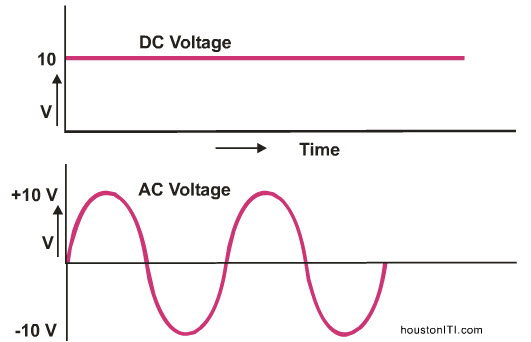 |
Summary of Differences between AC and DC - continued.
Having noted how dc entities behave, let's look at the lower figure to see how the AC voltage behaves. Here are some of the key items you can observe:
a. At time zero, the voltage is zero. Then as time increases, the voltage increases. After a certain time, it reaches a maximum value and then begins to decrease. After a certain time it becomes zero again. At this time an interesting thing happens. After reaching zero it keeps on decreasing and becomes negative.
What does negative voltage mean? It means that the voltage is applied in a direction which is opposite to the original direction. We can have the same situation in DC if we were to reverse the battery and cause the current to flow in the opposite direction. However, in the case of AC we don’t need to reverse anything, the system voltage automatically reverses itself.
b. On the negative side a similar pattern is repeated. The voltage increases to a negative maximum value and then begins to move toward zero. Eventually it crosses zero and gets into the positive territory and the whole process is repeated again.
c. We have already learned that the amount of current depends upon the magnitude of the voltage. In a DC system, the applied voltage causes a certain current to flow, and the magnitude of the current is steady – it does not change with time. On the other hand in the case of AC, the magnitude of the applied voltage and the resulting current vary with time. In this particular case, when the voltage is zero, the current is zero, and when it begins to rise, the current also begins to rise. In other words the current repeats the pattern set by the voltage wave. In this discussion we are assuming the load in the electrical circuit to be a simple resistor.
This type of alternating form is referred to as the “sinusoidal" form.